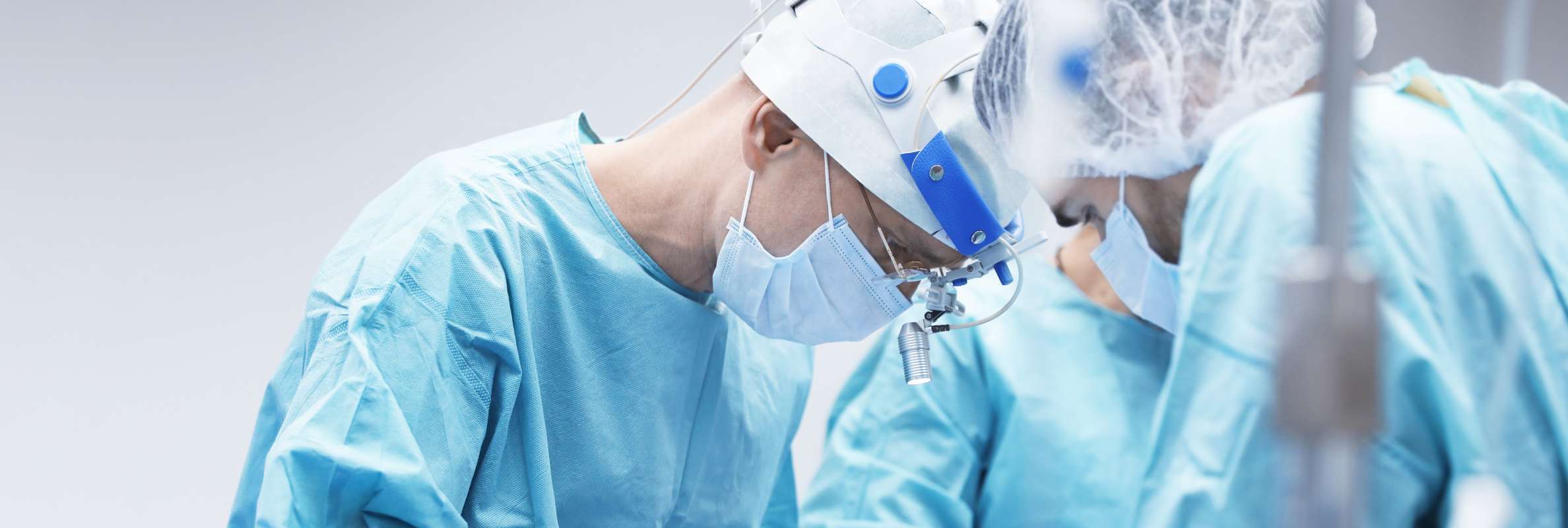Ventral abdominal hernias are any defects of the abdominal wall fascia, except inguinal and hiatal hernias. Millions of surgeries for these conditions are performed worldwide each year. Most of them are carried out in an open manner, under visual control. But in developed countries, minimally invasive surgery is preferred, including laparoscopic and robot-assisted techniques. We have prepared an overview of minimally traumatic and at the same time effective methods of hernia treatment.
Content
- Modern approaches to the treatment of abdominal hernias
- The MILOS and EMILOS techniques
- The PUMP technique
- Laparoscopic and robotic IPOM surgery
- Minimally invasive eTEP surgery
- Laparoscopic SCOLA surgery
- Where to receive treatment for abdominal hernia
Modern approaches to the treatment of abdominal hernias
A hernia can only be cured with surgery. Some hernias disappear over time in children, but in adults there is no self-healing: hernias will only increase in size, making subsequent treatment more difficult. No corsets or bandages can restore the integrity of the anterior abdominal wall tissues; they are only used to reduce symptoms for a short period of time.
Many hernias can become strangulated, causing serious complications. Treatment for complications is unlikely to be minimally invasive. In addition, it will become more traumatic, as it may be necessary to remove a fragment of intestine or other tissues damaged by the abrupt cessation of proper blood supply. To avoid such consequences, it is better to treat the hernia in a timely manner: it must be done routinely, not as an emergency.
Doctors often correct diastasis (divergence) of the rectus abdominis simultaneously with the hernia. Diastasis is not a hernia, it does not threaten strangulation and does not cause symptoms, and its correction is done for aesthetic purposes.
For hernia treatment, tension and non-tension techniques, open and minimally invasive surgeries are used. In recent years, predominantly non-tensioned hernia techniques have been used, as they provide a low recurrence rate. Minimally invasive hernia surgery has also become a trend in recent years, which allows to:
- Reduce traumatization
- Reduce the risk of complications
- Reduce postoperative discomfort
- Reduce hospitalization time
- Provide a better aesthetic result (no scars on the abdomen)
- Reduce the risk of recurrence
The choice of hernioplasty method depends on the size of the hernia gate, the state of the aponeurosis of the muscles of the anterior abdominal wall, the presence of impingement and the degree of oxygen deprivation of the affected organ. Most surgeries are performed routinely to repair unstrangulated abdominal hernias, so they can be performed using minimally invasive methods.
The MILOS and EMILOS techniques
The MILOS technique (MIni/Less Open Sublay) and an endoscopic option EMILOS (Endoscopic MILOS) are most commonly used for primary and postoperative hernias with diastasis recti. The endoscopic variant has been used in medicine since 2017, and in 2019 the effectiveness of the procedure has been proven for umbilical and epigastric hernias with hernia gates up to 1.5 centimeters in size, including cases without diastasis of the abdominal muscles.
How is the MILOS technique hernia treatment performed:
- For primary hernias, a transverse skin incision is made, and for postoperative hernias, the incision is made along the scar
- The hernia sac is separated
- The surgeon enters the retromuscular (posterior muscular) space
- The retromuscular spaces are joined
- If indicated, a surgeon performs a dissection (excision) of the tissues in the retromuscular space
- The hernia sac is repaired
- A mesh implant is placed in the weakened area of the abdominal wall
Proven benefits of this innovative treatment include a reduced risk of infectious complications, bowel perforation, risk of hernia recurrence, and incidence of abdominal pain during one year after surgery (Mitura K. et al. 2020).
The PUMP technique
The PUMP technique for hernia treatment (preperitoneal umbilical mesh plasty) is mainly used in hospitals in Germany, but is not yet popular in the rest of the world. It is a new technique, the peculiarity of which is the placement of the prosthesis outside the peritoneum, behind the rectus abdominis, followed by suturing of the ventral fascia.
The technique is suitable for people with ventral hernias of 2 to 4 cm without the need for reconstruction of the diastasis recti. Using the PUMP technique, physicians can place the mesh extraperitoneally (outside the peritoneum) without the risk of intraperitoneal complications.
In a 2020 study involving 81 patients, the high efficacy of the treatment with this method was demonstrated. Only 3.9% of patients experienced recurrence, three required repeated surgery, and 6.6% developed chronic abdominal pain due to the mesh implantation. The authors concluded that the PUMP technique reduced the risk of recurrence compared with suture techniques without increasing the risk of complications.
Laparoscopic and robotic IPOM surgery
Although IPOM is classically performed through umbilical access, some clinics perform this procedure laparoscopically and robotically. These are minimally invasive modifications of a similar open surgery.
IPOM (IntraPeritoneal Onlay Mesh) is used for ventral hernias up to 6 cm, and the IPOM+ variant, which differs in the way of suturing, is used even in cases of strangulated hernia. During the operation, the mesh is placed intraperitoneally (inside the peritoneum). Doctors implant it in such a way as to avoid contact with the large omentum and intestine. After fixation of the prosthesis, the hernia sac is sutured.
Minimally invasive eTEP surgery
The eTEP (Extended Totally Extra Peritoneal) operation is used for hernias up to 8 cm without diastasis recti or up to 6 cm with diastasis recti. Hernias up to 12 cm in size can be repaired with the eTEP-TAR surgery option. The intervention can be performed laparoscopically and robotically.
The essence of the operation: right and left retromuscular spaces are joined, hernia sac is repaired, fascia is sutured without tension, diastasis recti is sutured (if necessary). The mesh is implanted in the retromuscular space, without fixation. The recurrence rate even with large hernias does not exceed 5%.
Laparoscopic SCOLA surgery
One of the most popular surgeries in Europe, SCOLA (SubCutaneous Onlay Laparoscopic Approach), can also be performed laparoscopically. It is used for hernias up to 7 cm in size with diastasis recti. The mesh is implanted over the aponeurosis (onlay) and the umbilicus is fixed to the linea alba of the abdomen for cosmetic purposes. It is a safe operation with a recurrence rate of about 2%.
Where to receive treatment for abdominal hernia
If you want to undergo minimally invasive treatment with fast recovery using the latest advancements of international surgery, you should go abroad, to one of the developed countries of Europe. For example, you can go to the PAN Clinic Cologne in Germany.
You can check prices and make an appointment for convenient dates on the Booking Health website. Here you will get advice from a specialist in medical tourism, help in choosing a clinic and organizing your trip. The cost of surgery in Germany when booking through Booking Health will be lower than when applying directly to a medical center, due to the absence of additional fees for foreign patients.
Choose treatment abroad and you will for sure get the best results!
Authors:
The article was edited by medical experts, board certified doctors Dr. Nadezhda Ivanisova and Dr. Vadim Zhiliuk. For the treatment of the conditions referred to in the article, you must consult a doctor; the information in the article is not intended for self-medication!
Our editorial policy, which details our commitment to accuracy and transparency, is available here. Click this link to review our policies.
Sources:
National Center for Biotechnology
Scientific Research an Academic Publisher
Read:
Why Booking Health - questions and answers
How to make right decision when choosing the clinic and specialist
7 reasons to trust to the rating of clinics on the Booking Health portal
Don't know where to start?
Contact Booking Health






